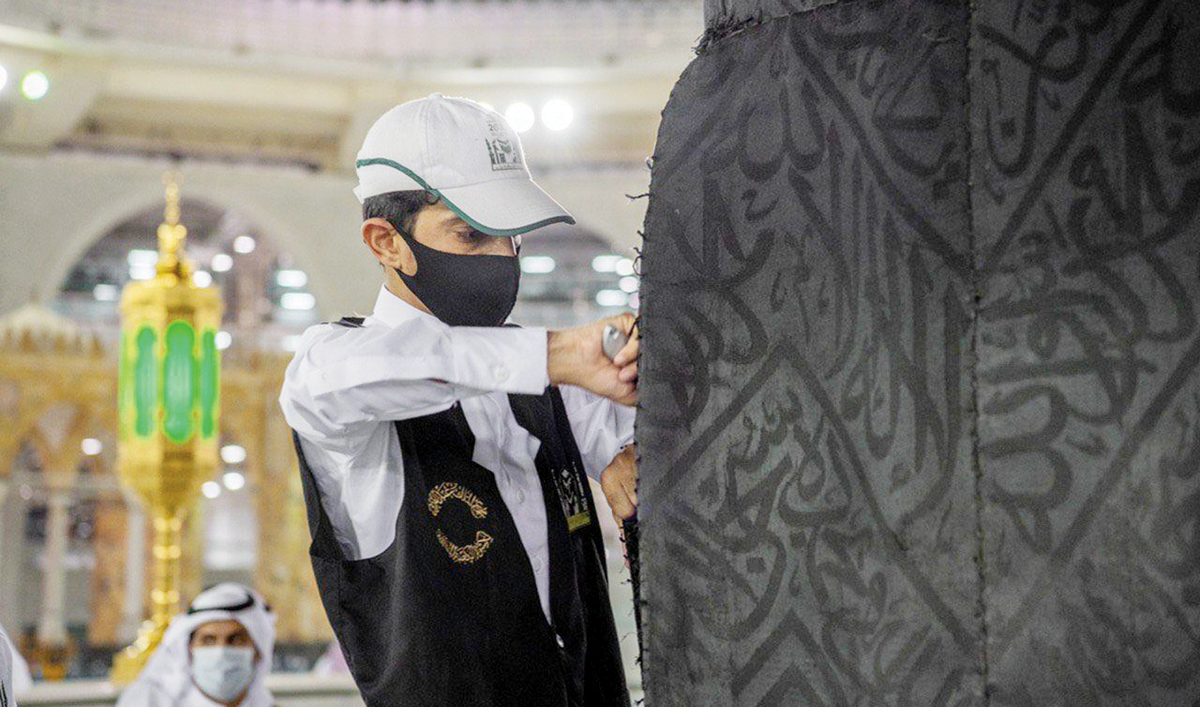MAKKAH: On behalf of King Salman, Makkah Gov. Prince Khalid Al-Faisal on Wednesday handed over the Kaaba Kiswa (black cloth) to the senior caretaker of the Kaaba, Saleh bin Zain Al-Abidin Al-Shaibi.
The Kiswa will be replaced on the ninth day of the month of Dul Hijjah, following in the footsteps of the Prophet Muhammad (s.a.w) and his companions.
It was reported that after the conquest of Makkah in the ninth Hijri year, the Prophet covered the Kaaba in Yemeni clothes as he performed his farewell pilgrimage.
The Kiswa is replaced once a year during Hajj after the pilgrims go to Mount Arafat, in preparation for receiving worshippers the next morning, which coincides with Eid Al-Adha.
Meanwhile, the General Presidency for the Affairs of the Two Holy Mosques has lifted the lower part of the Kiswa by about 3 meters and covered the raised area with white cotton fabric (approximately two meters in width from the four sides).
The move was designed as a precaution to maintain the cleanliness and safety of the Kiswa and prevent tampering with it.
The colors of the Kaaba’s coverings have seen regular changes through the ages.
The Prophet Muhammad (s.a.w) covered it with white-and-red striped Yemeni cloth, and Abu Bakr Al-Siddiq, Umar ibn Al-Khattab, and Uthman ibn Affan covered it with white. Ibn Al-Zubayr covered it with red brocade.
During the Abbasid era, it was draped once with white and once in red, while the Seljuk Sultan covered it with yellow brocade. The Abbasid Caliph Al-Nassir changed the Kiswa’s color to green and later to black brocade, and this has remained its color to the present day.
Dr. Fawaz Al-Dahas, director of the Center of Makkah History, told Arab News: “The Kaaba was covered once in white, once in red, and once in black, and the choice of color was based on the financial means in every era.”
Qubati fabric was brought from Egypt and was one of the best types of fabric used to cover the Kaaba. The Yemeni Kiswa was also a quality cloth and most famous at the time.
On why the colors changed over the ages, Al-Dahas said that white was the brightest color, but it was not durable. It often became torn, dirty, and impure as pilgrims touched it and because it was not practical or long-lasting it was replaced with black-and-white brocade and shimla, which was used for covering Arab tents.
“The varying financial means controlled the type of fabric used for the Kaaba’s Kiswa,” Al-Dahas added.
He noted that the way humans perceived the Kiswa evolved after that, and it was replaced with a red brocade and qubati Egyptian cloth. Also, an antaa, which is a rug of leather, or a musouh, a collection of rough clothes, would be added to it.
“The Kiswa used to get changed from time to time whenever the fabric was available. This has been the case in the eras of the Rashidun Caliphate, the Umayyads, and the Abbasids,” he said.
Black was finally chosen at the end of the Abbasid era because it was durable and could withstand being touched by visitors, pilgrims, and people from different cultures from around the world.
With the continuation of the Umrah season, Al-Dahas said that the Kiswa was lifted to the middle of the Kaaba to preserve it and to prevent people from touching it.
~News





